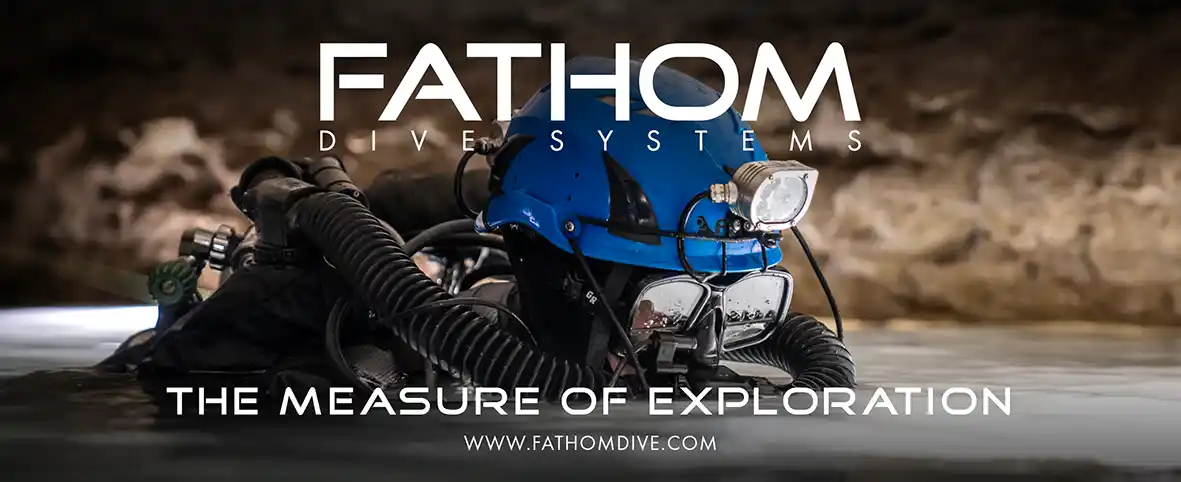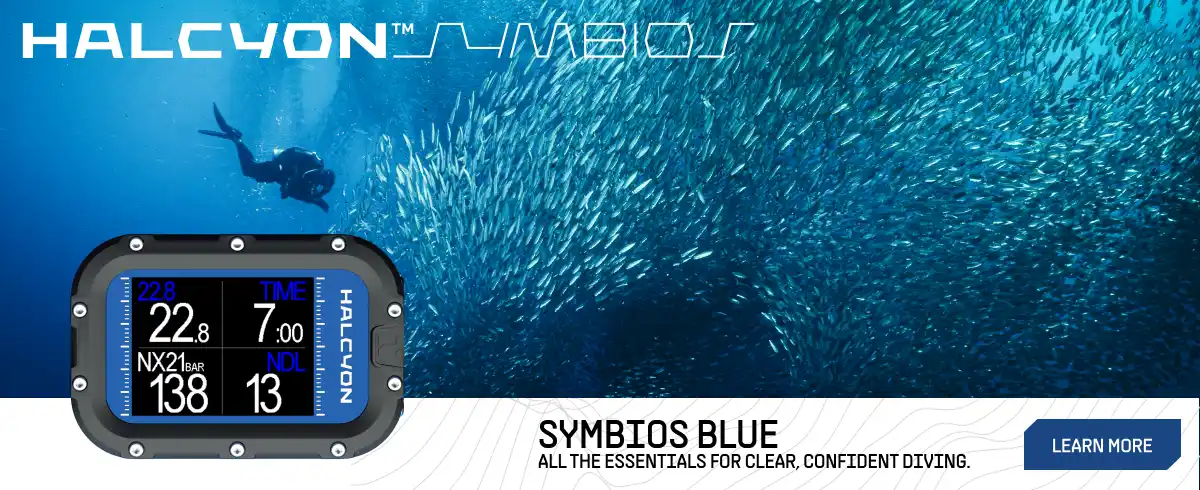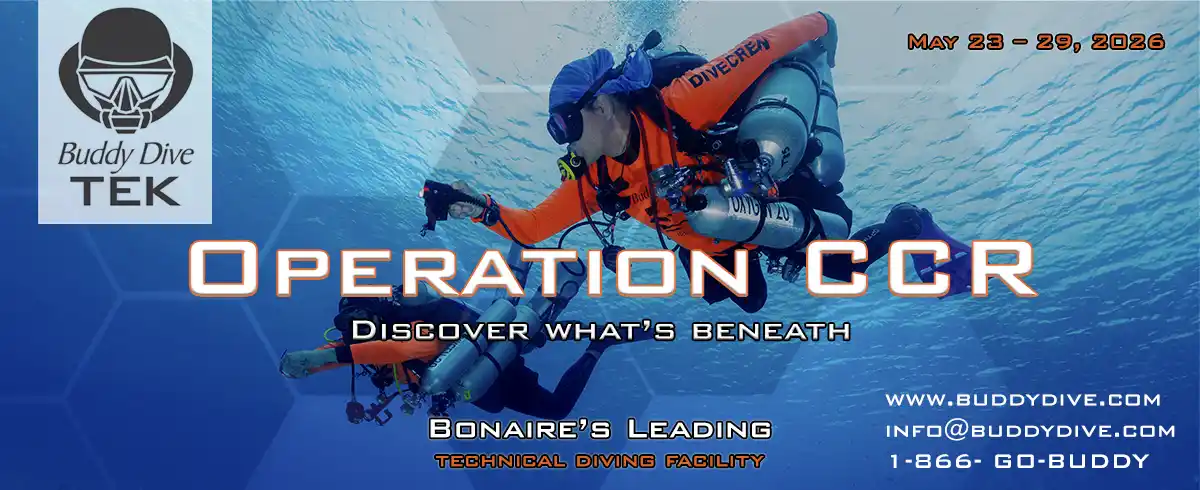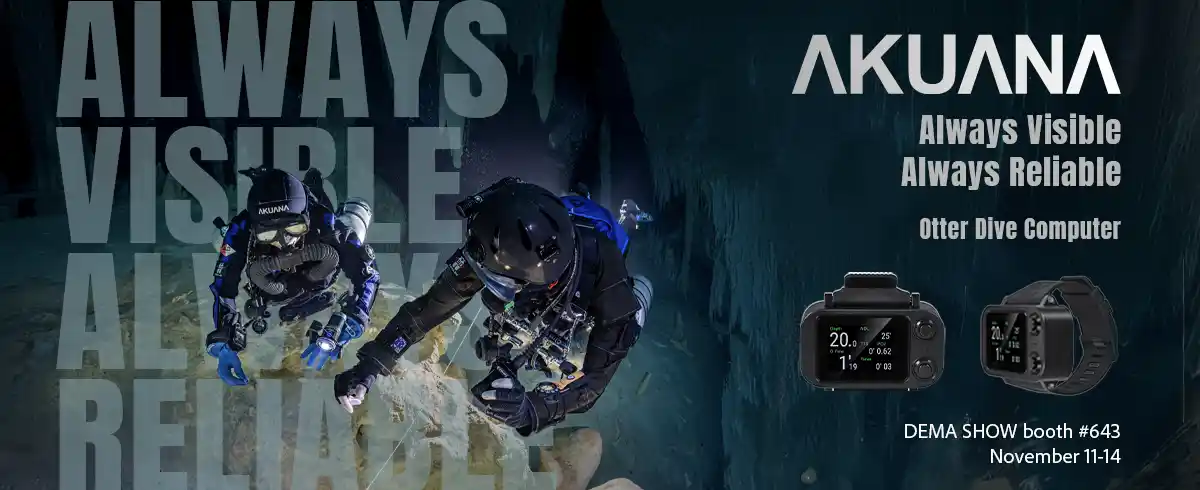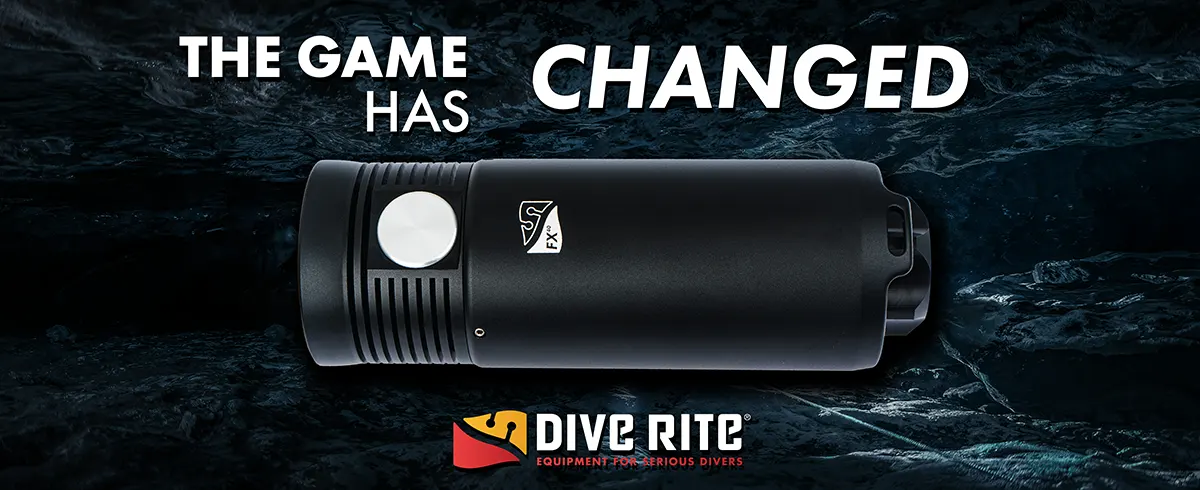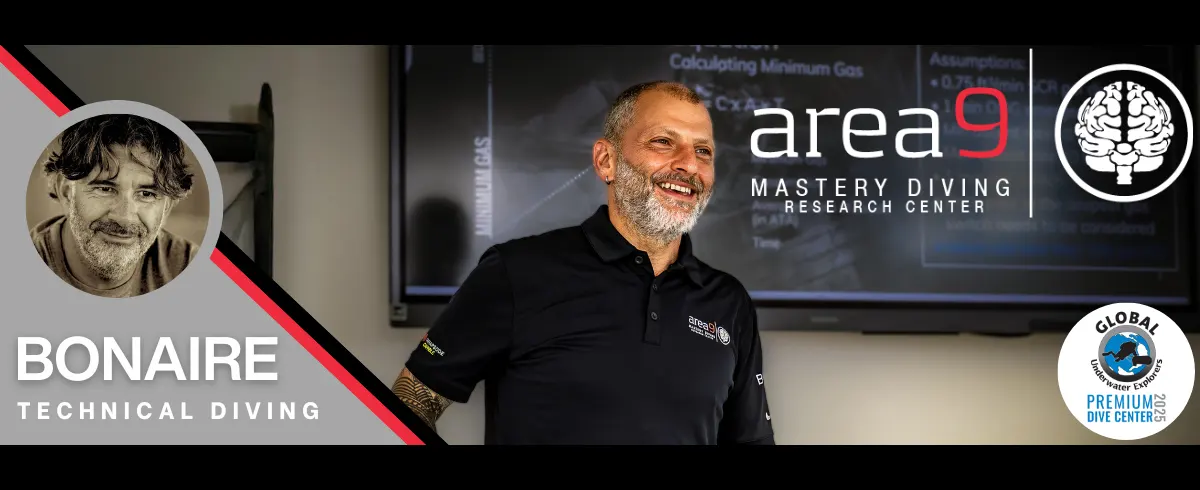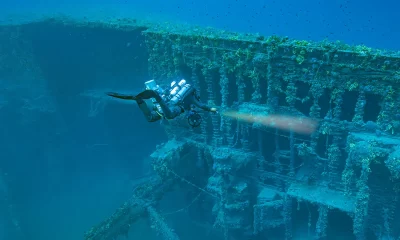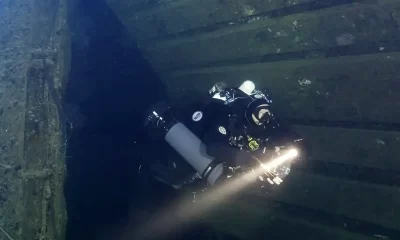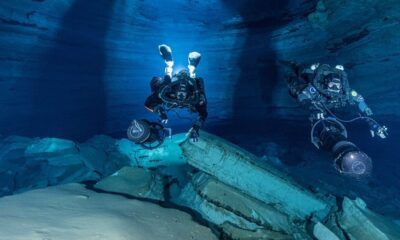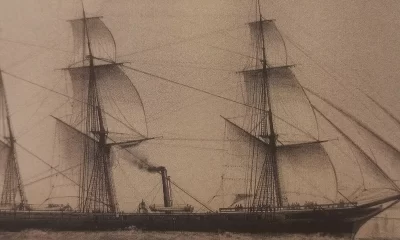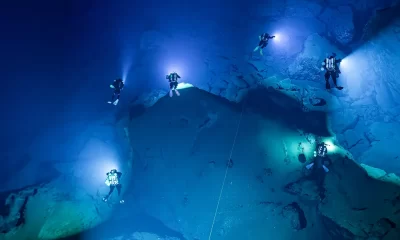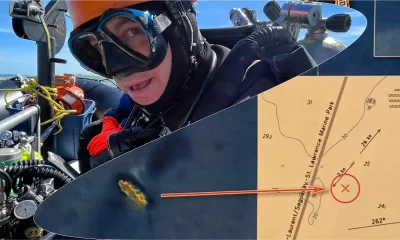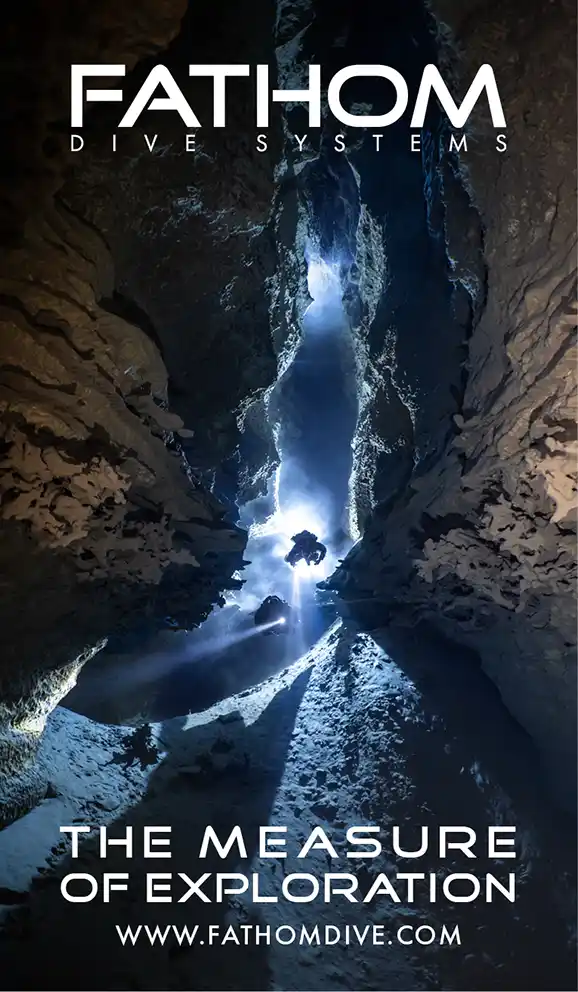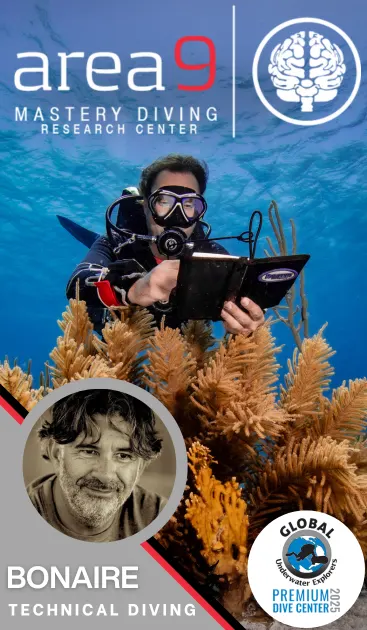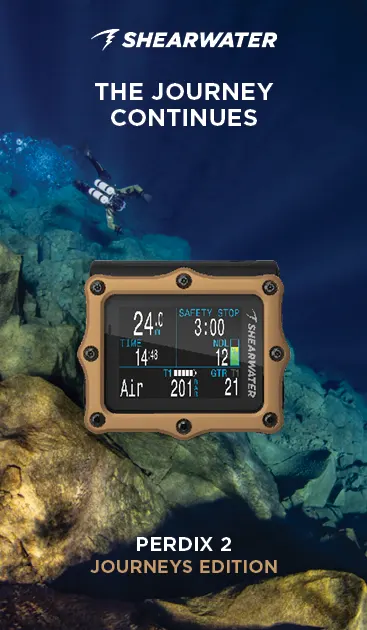Exploration
Sheng-loong Sinkhole Exploration Project 2024
by Craig Challen, Andrew Oakeley and Chen Qian. Photos courtesy of the author unless noted.

In April 2024, explorer Chen Qian (Charlie) invited Craig Challen and Andy Oakeley to form a team to do some deep exploratory dives in China. The prospective sites were DaXing Spring Cave and Sheng-loong (Shenglong) Sinkhole.
For background: in 2020 Charlie had been living in Du’an County during China’s coronavirus lockdowns, and he had taken that enforced period of isolation to complete dives down to 258 m/846 ft in DaXing Spring Cave. Since that time, he had been anxious to return. However, stopping him from doing so was the fact that the cave had been closed down since October of 2023 when diver Han Ting tragically died there while preparing for a world-record dive.
In spite of those circumstances, Charlie was hopeful that his local contacts could enable him to procure a special entry permit so he, Andy, and Craig could dive the cave. Additional appeal to all of them was that divers had not yet explored deeper than about 120 m/656 ft of their second target location, Sheng-loong, where an ROV had been operated beyond 200 m/656 ft. The sinkhole was rumoured to be up to 300 m/984 ft.
Craig was keen to explore DaXing Spring Cave further, having dived there in 2015. Should depth and conditions permit, dives using hydrogen diluent were also planned to continue the experimental program commenced by Richard Harris. Andy, having had his Dual JJ-CCR built since mid-COVID, was keen to get some 200 m+ dives under his belt.
With two prospective deep sites available, Craig and Andy obtained Chinese visas, booked flights to Nanning City, and departed in late March 2024 with more than 90 kg/198 lb of gear each, chasing the lure of the unknown.

Nanning
By Chinese standards, Nanning is a small city with a population of 7 million. It’s located in the Southeast corner of China about 130 km/80 mi inland and 150 km/93 mi from the Vietnam border. The climate is warm subtropical with an annual mean temperature of 22.3 °C/72.1 °F. Summers are hot and humid; in July, the hottest month, 24-hour average temperatures crest 28.5 °C/83.3 °F. Winters are mild and rainy. January is the coolest month, averaging 13.3 °C/55.9 °F. Rain is most frequent in the spring and summer months, and relative humidity consistently averages above 80 percent. The annual rainfall is 1,269 mm/50 in.
When Craig and Andy arrived in Nanning, Charlie informed everyone that, despite contacting all the right local officials, he had been unable to get a permit for DaXing Spring Cave. He checked Craig and Andy into a hotel in Wuxu in the Jiangan district of Nanning, just a short ride from Nanning Airport and a five-minute drive or 30 minute walk from Shenlong Park. This was to be their accommodation for the next few weeks.

Sheng-loong (Shenglong) Sinkhole
Shenlong Sinkhole is the centrepiece of Sheng Longtan Park and is surrounded by industrial and agricultural enterprises, tower blocks (some abandoned), local eateries, convenience shops, small supermarkets, and hardware stores.
Sheng Longtan Park is in the final stages of development as a recreational water sports hub for the region. Once completed, it will have an onsite hotel, fully fitted dive shop, camping facilities, and more. Currently completed and functional are the main building (which has a coffee shop and basic snacks and drinks), camping areas, landscaping, toilet blocks, and ancillary buildings. We set up in one of the ancillary buildings which was already being utilized by the freedivers that frequent the lake. Charlie and the support team provided compressors, tanks, weights, and all the extras needed for diving.
The sinkhole itself is rumoured to be over 300 m/984 ft deep and has been explored to some degree by ROV, though the details of the ROV exploration were unclear. The team did find the following information, however:
- The ROV team believed that there was a cave/cavern in the southeast corner of the lake at about 250 m/820 ft.
- There was a 300 m deep section further out in the lake.
Other divers weighed in with what seemed like a hundred different ideas as to what Craig, Andy, and Charlie should do and how they should do it—all of those ideas expressed in a language that Craig and Andy could not understand. So, to some degree, they were at the mercy of the support team and where the team told them to dive. In the end, though, they just needed to start diving.

After re-building an abandoned floating jetty (not strictly required, but it was there and seemed like a good idea at the time) and assembling and prepping their gear, Craig and Andy popped into the water for a checkout dive. A short swim out from shore saw them easily drop down a wall to 50 m/165 ft. The wall appeared to just keep going, which was a good sign.
Water temp was 24 °C/75 °F down to 21 °C/70 °F with visibility of about 4 m/13 ft: not great, but good enough. Apparently, though, between November and February, the lake’s visibility improves to 20 m/65 ft but deteriorates rapidly through March until October, and the team was diving in April.


A subsequent dive to 120 m/394 ft the next day went well, and it appeared that the wall still continued downwards.
After taking a day off because the park was closed for a national holiday, the team put in a descent line. There seemed to be considerable debate amongst the support team about whether to have a descent line or just follow the wall, where to put the descent line, if there was one, and if it was to be either two-thirds of the way across the lake in the area rumoured to be 300 m or in the 250 m section—closer to shore where the cave was rumoured to be. It seemed that nothing in China happened without hours of conversation beforehand. In the end, the support team found a two hundred-plus-meter spot about one-third of the way out into the lake, and that’s where the line was destined to be.

Deep Dive 1
With the shot line now in place, it was decided that the sensible thing to do would be to dive down it and see how deep it really was. Craig and Andy planned a dive to 220 m/722 ft, and Charlie planned to go to the bottom of the line.
- Charlie found the bottom of the line at 229 m/751 ft and reported that the ground sloped away from there.
- Craig had some fun hauling himself back up the shot line for a bit when his diluent regulator decided that delivering gas (needed for wing inflation) below 200 m was not something it wanted to be a part of anymore.
- Andy was stoked to complete his first dive beyond 200 m/650 ft, to finally use the Dual JJ-CCR for the purpose it had been built for, and to confirm that it actually worked quite well at those depths.
- It looked like there was potential for this to continue deeper—maybe even into a cave of sorts.
Deep Dive 2
With the first dive out of the way, Charlie and Craig planned their second dive to explore from the end of the line down the slope, and Andy just planned to go to the bottom of the shot line (229 m/751 ft) and back. The second dive also allowed all three divers to get more of a feel for what they were dropping into; they realised that, at about 150 m/492 ft, they were passing an outcrop and entering a gorge of sorts in the bottom of the lake. Craig and Charlie ran a line down the floor of the gorge to 250 m/829 ft and wished they had scooters. With the limited visibility and lack of scooters, it was difficult to tell if they had entered the cave or not.

Deep Dive 3
Taking a few days off from deep diving allowed Andy and Craig to install the collapsible habitat that Craig had brought with him into the lake. Craig and Charlie were to use this on the next —and final—deep dive.
On this dive, Craig and Charlie planned to swim to the end of the line, extend it some more, ascend from the end of the line to determine if they were in a cave/cavern, and then reel the line back in.
Andy planned to swim down the line to 240 m/787 ft and then return, thus keeping his deco obligation down to around 7.5 hours and leaving the habitat available for Craig and Charlie whose dive plan was 10.5 hours.
Again wishing they had scooters, Craig and Charlie explored the end of the line and concluded that they were, at the very least, in a cavern not dissimilar to El Zacaton—made famous by Sheck Exley’s dives there—if not the start of a cave.
Whether this gorge extended further or not, or into a cave system or not, will have to be determined by an exploration team on another day. But it was concluded that, if El Zacaton could be called a cave dive, this was also a cave dive.

Future diving in Shen-Loong Sinkhole
Further exploration of this site is definitely warranted. There is already a plan by to do more exploration by ROV to better map the site. With the excellent facilities on site, proximity to hotels and shops, availability of warm water year-round, and the promise of better visibility from November to February (when it is also cooler on the surface), it is an exciting proposition for future exploration.
It is worth noting, for anyone else who wants to go diving in Sheng-loong Sinkhole, that the management of the park is friendly to technical divers (they bought the habitat from us before we left), and they can easily do 100-plus m dives straight off the shore. Access to O2 and helium and a booster would need to be arranged in advance through one of the technical diving centers in Nanning, and they would need an invitation from the park management (or someone else in China) to get a visa, which could be easily arranged. For deeper dives, if they want a descent line in the middle of the lake and tow out to the line, they will also need to arrange for and pay for support from one of the local dive teams or dive centers.
Getting there is not too difficult, but unfortunately there were no direct flights from Perth to Guangzhou at the time of this trip. So, Craig and Andy departed on a long, 24 hour mission: Perth to Sydney to Guangzhou to Nanning (again, with about 90 kg of gear each). It has since been determined that flying from Perth to Hong Kong and then catching the bullet train to Nanning (704 km/437 mi in 4 hours) would have been shorter, though would have involved some luggage wrangling in Hong Kong to transfer to the train.
This trip was incredibly well supported by Wolf, his team from Vic’s Diving Base, Bai from 200BAR Dive Centre Liuzhou, and numerous individual divers who did everything from setting the shot line, towing divers out using a RIB, assisting with moving gear, and anything else the visiting divers needed. Most of the supporting divers spoke a fair amount of English, and Google Translate filled in the gaps. For us, having our own translator on hand, Charlie mostly, made life easier.


It is not possible to name everyone who helped us with this project in China, but special thanks to:
- Charlie for coordinating everything and inviting us
- Bai, Belinda, Julie, Cyril, and FeiFei for their above ground and in water support
- Wolf, Grape, and team from Vic’s Diving Base for their surface support
- Sammi for giving us access to Sheng Longtan park and its facilities and buildings
- Wonder the freediver and Yang for driving the gear cart and constantly smiling
- Alina the photographer for excellent land photos and RouRou for ordering the food
Return to Deep in Sheng-loong Sink

Andrew Oakeley is an IT Consultant with 10 years of experience in technical diving. He is passionate about encouraging people to further their technical diving skills and is a driving force behind many Western Australian and overseas diving projects.
A founding member of the Wrecksploration dive team, he enjoys diving in the ocean as well as in caves. Andrew built a Dual JJ-CCR for dives below 250 m and used it for his dives in Shen-loong Sinkhole.

Craig Challen is a veterinarian, businessman, adventurer, pilot and cave diver from Perth, Western Australia and a member of the Wetmules diving team. In 27 years of cave diving he has explored caves throughout Australia and the world. He has a particular interest in deep, cold-water caves but will take on anything that offers the chance of going somewhere that nobody has been before.
In July 2018 he participated in the Tham Luang cave rescue in northern Thailand, in which 13 people were rescued after 17 days trapped over two kilometres inside a cave by flood waters.




